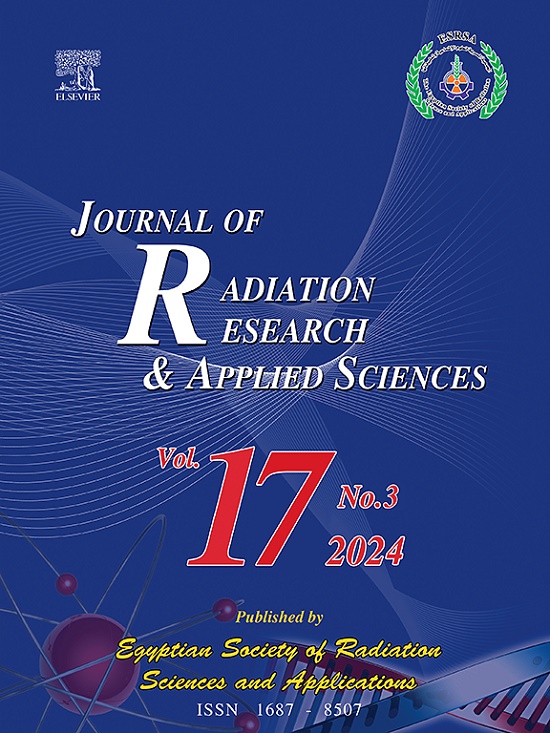含Navier滑移、热跳变和二次辐射的多孔垂直盘结构传热与不可逆性分析:基于Corcione相关的数值研究
IF 2.5
4区 综合性期刊
Q2 MULTIDISCIPLINARY SCIENCES
Journal of Radiation Research and Applied Sciences
Pub Date : 2025-06-12
DOI:10.1016/j.jrras.2025.101678
引用次数: 0
摘要
本研究提出了Corcione相关性,强调了流体温度、颗粒体积分数和颗粒尺寸对纳米流体传热率提高的影响。本研究考察了由Al2O3/H2O组成的纳米流体在垂直延伸或收缩的圆盘上的滞止点流动。该研究是在28、30和45 nm的纳米颗粒尺寸下进行的,体积浓度高达4%。Navier速度滑移和热滑移条件增强了数学模型。它还研究了磁流体动力学、吸力、多孔介质、焦耳加热、二次热辐射、粘性耗散和熵的产生的影响。bvp4c求解器对由偏微分方程相似变换而成的常微分方程组进行数值求解。对于拉伸和收缩场景,图表说明了几个相关因素的影响。拉伸时,Navier滑移参数、孔隙度、磁场和质量吸力参数均呈下降趋势;然而,在收缩的情况下,可以看到相反的行为。在两种情况下,温度分布随着纳米颗粒体积分数、辐射和温度比因素的增加而增加。这两种情况都表明布林克曼数的熵产增加,而温差的熵产减少。测量了dp = 28、30和45 nm纳米颗粒尺寸下的表面摩擦和努塞尔数。在dp = 45 nm时,Nusselt数大于28 nm和30 nm,而在28 nm时,表面摩擦力较大。现在的结果和以前的结果几乎完全一致(相对误差约为0%)。本文章由计算机程序翻译,如有差异,请以英文原文为准。
Heat transfer and irreversibility analysis in porous vertical disk configuration with Navier slip, thermal jump and quadratic Radiation: Numerical study using Corcione's correlation
This study presents the Corcione correlation, emphasizing the effects of fluid temperature, particle volume fraction, and particle size on the improvement of nanofluid heat transfer rate. This study examines the stagnation point flow of a nanofluid consisting of across a vertically extending or shrinking disk. The study is conducted for nanoparticle sizes of and nm, with volume concentrations reaching up to 4 %. The Navier velocity slip and thermal slip conditions enhance the mathematical model. It also looks at the effects of magnetohydrodynamics, suction, porous media, Joule heating, quadratic thermal radiation, viscous dissipation, and the production of entropy. The bvp4c solver numerically solves the system of ordinary differential equations created by the similarity transformation of the partial differential equations. For both the stretching and shrinking scenarios, graphs and tables illustrate the effects of several relevant factors. In the event of stretching, the velocity profile exhibits a declining trend for the Navier slip parameter, porosity, magnetic field, and mass suction parameters; in the case of shrinking, however, the opposite behavior is seen. The temperature profile increases with the nanoparticle volume fraction, radiation, and temperature ratio factors in both scenarios. Both cases show an increase in entropy production for the brinkman number and a reduction in entropy generation for the temperature difference. Skin friction and Nusselt number are measured for dp = 28, 30, and 45 nm nanoparticle sizes. The Nusselt number is larger for dp = 45 nm than 28 nm and 30 nm, while skin friction is higher for 28 nm. There exists an almost perfect concordance (with a relative error of around 0 %) between the present and previous results.
求助全文
通过发布文献求助,成功后即可免费获取论文全文。
去求助
来源期刊

Journal of Radiation Research and Applied Sciences
MULTIDISCIPLINARY SCIENCES-
自引率
5.90%
发文量
130
审稿时长
16 weeks
期刊介绍:
Journal of Radiation Research and Applied Sciences provides a high quality medium for the publication of substantial, original and scientific and technological papers on the development and applications of nuclear, radiation and isotopes in biology, medicine, drugs, biochemistry, microbiology, agriculture, entomology, food technology, chemistry, physics, solid states, engineering, environmental and applied sciences.
 求助内容:
求助内容: 应助结果提醒方式:
应助结果提醒方式:


